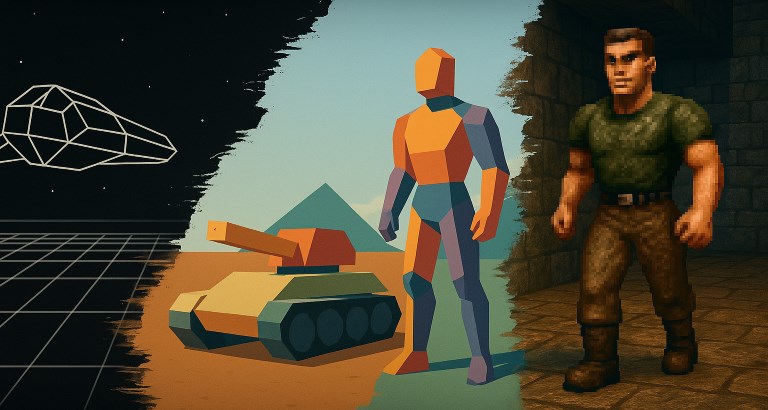
When people talk about the birth of 3D games, names like Quake or Super Mario 64 often come up. These titles were revolutionary, no doubt—but to say they were the first 3D games erases an entire decade of groundbreaking work done by developers on much more limited machines.
To understand how 3D games truly evolved, we need to look at the hardware—because it wasn’t just creativity that shaped early 3D—it was silicon.
🎮 My First 3D Experience
I still remember the first time I saw Elite running on an 8-bit machine. Just sitting there, watching this angular wireframe spaceship rotate on the screen... it felt like a glimpse into another universe. It was the mid-80s, and compared to the colorful 2D sprites of the time, this thing looked alien—in the best way possible.
That moment stuck with me—not because the graphics were flashy, but because they defied what I thought the machine could even do.
3D on 8-bit Systems: Wireframes and Imagination
In the mid-1980s, firing up Elite on an 8-bit computer like the BBC Micro or Commodore 64 was a mind-blowing experience. The game presented players with a vast, navigable galaxy rendered entirely in wireframe 3D. For many, it was the first glimpse into a 3D world—even if that world was made of little more than white lines on a black background.
So yes, 3D games were already possible on 8-bit systems. But it wasn’t easy.
These machines had severe limitations: low clock speeds (1 MHz), minimal RAM, no dedicated graphics hardware, and restrictive color formats. Drawing a single wireframe model in real-time was already a feat. Anything more—like filled polygons or shading—was practically out of reach.
Despite this, clever programmers managed to do a lot with a little. They optimized math routines, made the most of fixed-point arithmetic, and worked within tight memory budgets. But the ceiling was low. The hardware dictated just how ambitious a 3D project could be.
The 16-bit Leap: Enter the 68000 Era
When 16-bit systems like the Amiga and Atari ST arrived, the scene changed dramatically. With CPUs like the Motorola 68000, developers suddenly had access to sixteen 32-bit registers, hardware multiplication and division, and support for palette-mapped graphics with more colours. It was like stepping into a new world.
These machines allowed for the jump from wireframe to flat-shaded filled polygons. But even here, the hardware imposed strict boundaries.
Rendering a filled polygon scene is much more expensive than a wireframe one—not just because of the math involved in rasterization, but also because of overdraw. Basic occlusion was usually handled via backface removal and Z-sorting, but that wasn’t always enough to keep the scene efficient. Color depth was another constraint. Without enough shades to work with, developers couldn’t do much more than flat fills.
Games like Starglider II, Stunt Car racer and Carrier Command managed to pull off convincing 3D scenes, but it was always a battle against the machine’s limits. Developers had to be extremely careful about how many polygons they pushed, how often they updated the screen, and how much memory they consumed.
📊 Timeline: 3D Evolution by Hardware Generation
| Era | Platform | Major 3D Capability | Key Example Games |
|---|---|---|---|
| Early 80s | ZX81, C64, BBC Micro | Wireframe only | 3D Monster Maze, Elite |
| Late 80s | Amiga, Atari ST | Flat-shaded polygons | Driller, Starglider II |
| Early 90s | 386/486 DOS PCs | Texture-mapping becomes viable | Wolfenstein 3D, Descent |
| Mid 90s | Pentium + GPUs | Real-time texture + lighting | Quake, Tomb Raider |
🧮 Pixels Per Second: The Real Bottleneck
At the heart of every 3D breakthrough is one brutal equation:
CPU MIPS / (Desired FPS) / (Screen Pixels) = Cycles per pixel
On 486-era PCs, you finally had enough bandwidth to push full scenes at playable frame rates—if you optimized heavily. A chunky 8-bit pixel framebuffer (like 320×200x8) gave you direct access and kept memory usage down. Add in a fast CPU and enough RAM to hold texture data, and you could finally do real-time 3D with texture mapping.
Games like Ultima Underworld and Wolfenstein 3D cracked the door open, and by the time Quake hit in '96, the door had been kicked wide open.
🎯 Conclusion: Step by Step, Frame by Frame
3D gaming didn’t explode out of nowhere—it evolved, one frame at a time. Every generation of hardware set the ceiling for what developers could achieve, and every innovation in CPU, memory, or video hardware opened new doors.
The early 3D pioneers didn’t wait for permission. They squeezed every cycle, hacked every register, and tricked every display chip into doing what it was never meant to do—all in the name of chasing that extra dimension.
So while Quake and Mario 64 were turning points, let’s not forget the decades of 3D ingenuity that paved the way—one pixel at a time.



